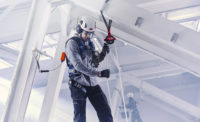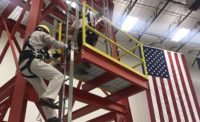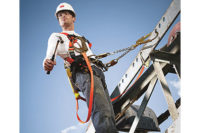Imagine working 20 feet above the ground. Now imagine working on top of a roof over 50 feet off the ground. And now think about being 50 stories in the air while building a skyscraper. Fall protection equipment is an essential component of your safety, but you also need to know how to use the equipment properly. For this, you need appropriate training and an understanding of what is required to be compliant.
Leading Edge Protection
One of the most dangerous aspects of working at height are leading edge hazards. This is often construction work that is performed at an unprotected edge, perimeter or border where a fall hazard exists. Typically, a leading edge situation will force a lifeline or lanyard to ‘bend’ over the edge in the event of a fall over the edge. Moreover, many leading edges also present sharp edge hazards that can fray or even sever a lifeline as it bends over the edge. Other hazards that exist due to leading and sharp edge situations include:
- Increased fall distance because typical anchor point is at foot level
- Increased fall clearance requirement due to the increased fall distance
- Increased arresting forces
- Unpredictable lock up speed – a self-retracting device will only sense a fall when user’s D-ring moves past the leading edge
- Increased potential for swing falls
Currently, the ANSI/ASSP Z359.14 standard for Self-Retracting Lifelines (“SRLs”) has specific test criteria that include testing to simulate added free fall distance, testing performed over sharp steel edge (.005 inch radius), and testing for swing fall over steel edge as well as straight down.
Note that there is a difference between leading edge (“LE”) and non-leading edge rated fall protection equipment. With LE equipment, the lifeline material is typically larger, stronger, and more cut resistant. You can use LE rated products on a variety of edge surfaces, such as concrete, and they can be used on finished concrete with a rounded edge. It is important to remember though that a Competent Person must be involved in selecting the appropriate equipment for your application and have ownership of the setup, which involves training. You can also consult with technical advisors from your equipment manufacturers about your specific application needs and reference ANSI Z359.
All ANSI/ASSP Z359.14 LE devices MUST have a shock absorbing method between the worker and the SRL. There are also clearance requirements for LE rated products. Typically, more fall clearance is required because of added free fall distance when anchored at foot level. The exact clearance depends on product type, anchorage point location, and user weight. For example, some SRL models anchored at foot level, set back from edge and with swing fall possible, will exceed 15 ft. of required fall clearance.
Training
Equipment is only one part of the equation when it comes to protecting workers at height. Fall protection equipment and other PPE devices are often not used properly, thus creating an inefficient or unsafe system. Training on how to use the equipment properly and how to work safely in dangerous environments is paramount. Whether you enroll workers at a training center, or have training conducted on-site, or employ new models such as virtual reality training (VR), make sure your workers know how to use their equipment in a safe and compliant manner.
When protecting workers who are tasked with working at height, make sure they are properly protected with quality products and training so they can feel confident to do their job properly.



